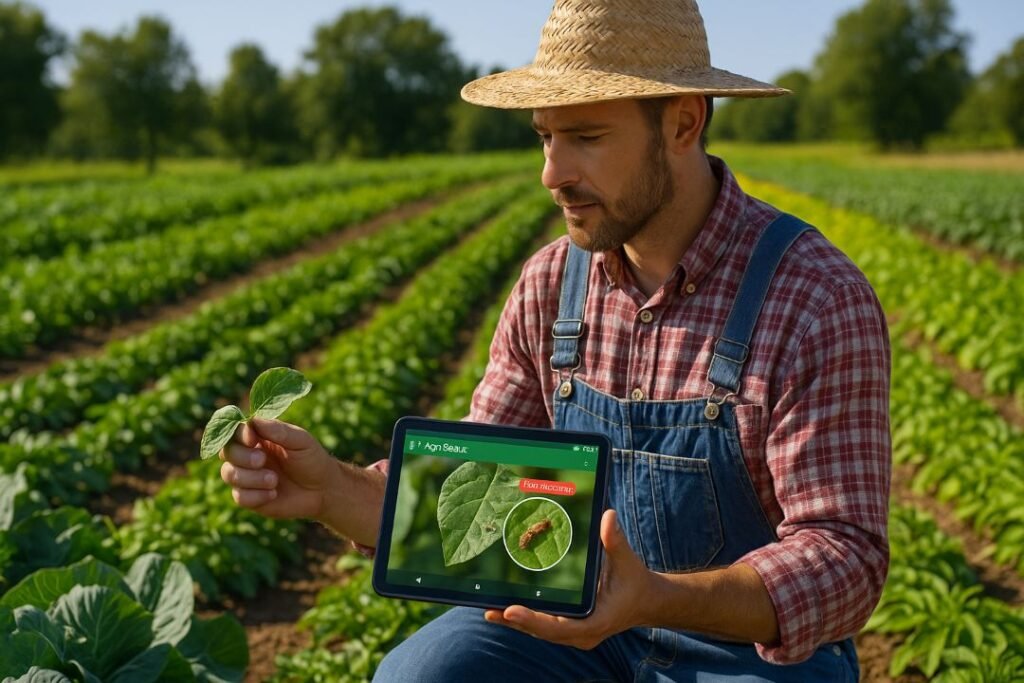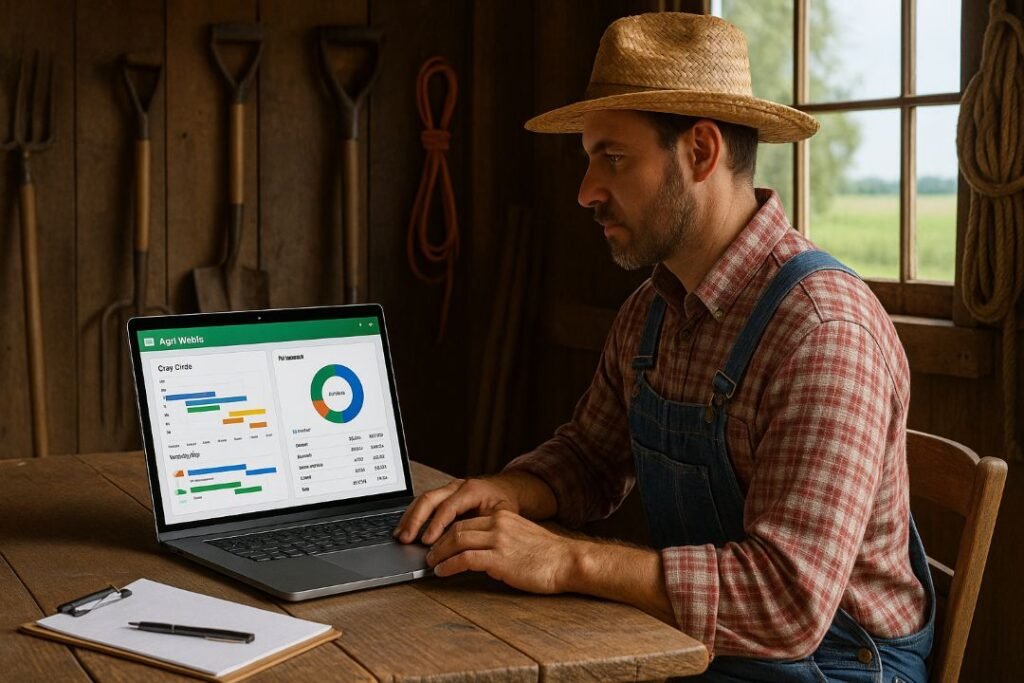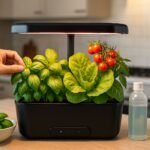Introduction
In today’s data-driven world, smart farming tools for small farmers are revolutionizing agriculture, enabling small-scale operations in the USA to compete with larger farms. These affordable technologies help farmers boost yields, cut costs, and tackle challenges like labor shortages and climate variability. With the global population projected to reach 9.8 billion by 2050, small farms—producing 50% of the world’s food on just 25% of farmland—must adopt innovative tools to stay sustainable and profitable (FAO, 2020). This article explores the best smart farming tools for small farmers, offering practical, affordable solutions to enhance productivity.
What is Smart Farming?
Smart farming, often called precision agriculture, uses advanced technologies to optimize farm operations through data-driven decisions. By integrating tools like the Internet of Things (IoT), artificial intelligence (AI), GPS, and sensors, IoT in agriculture for small-scale farmers enables real-time monitoring of crops, soil, and livestock. Similarly, precision agriculture for small farms ensures resources like water and fertilizers are applied only where needed, reducing waste and improving yields. These technologies make farming more efficient and sustainable (IoT For All, 2024).
Why Small Farmers in the USA Need Smart Farming Tools
Small farmers in the USA, defined by the USDA as those with annual sales under $500,000, face significant challenges: labor shortages, unpredictable weather, and low yields. According to the USDA’s 2022 Census of Agriculture, 89% of U.S. farms are small, yet they struggle to compete due to limited resources. Smart farming tools for small farmers address these issues by automating tasks, optimizing inputs, and providing actionable insights. For example, smart irrigation can reduce water usage by up to 60%, while drones can cut fertilizer costs by 15-20% through targeted application (FarmstandApp, 2025). These tools empower small farmers to maximize productivity while staying environmentally conscious.
Top 10 Smart Farming Tools Every Small Farmer Should Know
Here are ten affordable and effective smart farming tools for small farmers that can transform small-scale agriculture in the USA.
4.1. Smart Irrigation Systems
Best smart irrigation systems for small farms, like Rachio, Netafim, and CropX, use IoT sensors to monitor soil moisture and weather data, delivering water only when and where needed. These systems can reduce water usage by 30-60% compared to traditional methods, saving costs and improving crop health (FarmstandApp, 2025). For example, Netafim’s drip irrigation integrates with smartphone apps for remote control, ideal for farms under 20 acres. Many systems also qualify for USDA cost-sharing programs, making them accessible for small budgets.
4.2. Soil Sensors
Affordable soil sensors for small farmers, such as Teralytic and Arable Mark, provide real-time data on soil moisture, pH, and nutrient levels. Priced as low as $30-$80, these sensors connect to mobile apps, helping farmers prevent overwatering and optimize fertilization (FarmstandApp, 2025). By eliminating guesswork, soil sensors can boost yields by 15-25% while reducing input costs, making them essential for small-scale operations.
4.3. Drones for Crop Monitoring
Drone technology for small farm crop surveillance is now accessible with models like DJI Agras and Sentera, starting under $500. Drones capture high-resolution images to detect pest infestations, nutrient deficiencies, and irrigation issues early. They can survey 5-10 acres in 20 minutes, enabling targeted interventions that save crops and reduce treatment costs by 15-20% (FarmstandApp, 2025). This makes drones ideal for small farmers seeking precision on a budget.
4.4. GPS-Guided Mini Tractors
GPS-guided tractors for small-scale agriculture, like John Deere’s AutoTrac system, enhance planting precision, reducing seed and fertilizer waste by up to 15%. These compact systems, starting at $700, adjust seeding density based on soil conditions, ensuring optimal plant spacing (FarmstandApp, 2025). Small farmers can retrofit existing equipment with GPS tools, making this a cost-effective solution for farms under 10 acres.
4.5. Mobile Farming Apps
Mobile apps for crop monitoring in small farms, such as Plantix and FarmLogs, simplify farm management. These apps track planting schedules, input costs, and crop health, often offering free basic tiers. Plantix uses AI to identify pests and diseases via photo uploads, while FarmLogs consolidates data for better decision-making. Farmers report up to 15% cost savings by using these apps to optimize operations (FarmstandApp, 2025).
4.6. AI-Powered Pest & Disease Detection

AI-based pest detection tools for small-scale farming, like PEAT’s Plantix and AgroScout, use machine learning to analyze crop images for early signs of pests or diseases. These tools enable targeted treatments, reducing pesticide use by up to 40% (FarmstandApp, 2025). Affordable and user-friendly, they help small farmers act quickly, preventing crop losses and improving yields.
4.7. Automated Weeders
Automated weeding solutions for small vegetable farms, such as FarmWise Titan FT-35, use robotics to remove weeds with precision, reducing labor costs and herbicide use. Priced for small-scale operations, these tools save hours of manual weeding while promoting sustainable practices (FarmstandApp, 2025). They’re particularly valuable for organic vegetable farms aiming to minimize chemical inputs.
4.8. Weather Forecasting Tools
Tools like Sencrop and Climacell provide hyperlocal weather forecasts, helping farmers plan irrigation and planting with precision. By integrating with smart irrigation systems, these tools reduce water waste and protect crops from extreme weather. Sencrop’s weather stations, for example, track temperature, humidity, and rainfall, offering data-driven insights for small farms (Farmonaut, 2025).
4.9. Livestock Monitoring Devices
For small-scale livestock farmers, devices like Cowlar and Moocall monitor animal health, activity, and reproduction. These wearable IoT sensors track temperature, movement, and feeding patterns, improving herd management and reducing losses. Cowlar’s collar tags, for instance, provide real-time alerts, helping farmers save on veterinary costs (Farmonaut, 2025).
4.10. Farm Management Software

Software like AgriWebb and Granular streamlines farm operations by managing finances, crop cycles, and inventory. These platforms offer free or low-cost tiers, making them accessible for small farmers. By analyzing historical data, they help predict yields with up to 85% accuracy, optimizing resource allocation and profitability (FarmstandApp, 2025).
Comparison of Top Smart Farming Tools
| Tool Name | Purpose | Best For | Cost Estimate |
|---|---|---|---|
| Plantix | Disease detection | Small vegetable farms | Free / Freemium |
| DJI Agras | Aerial monitoring | Field crops | $$$ |
| Netafim | Smart irrigation | Row crops, orchards | $$ |
| FarmWise Titan | Automated weeding | Vegetable farms | $$$ |
How to Choose the Right Smart Tool for Your Farm
Selecting the right affordable smart farming equipment depends on several factors:
- Budget: Start with low-cost options like soil sensors or free apps like Plantix.
- Farm Size: Drones and GPS tractors suit larger plots, while sensors work for any size.
- Crop/Livestock Type: Choose tools specific to your needs, like livestock monitors for dairy farms.
- Tech Literacy: Opt for user-friendly tools with mobile apps and minimal setup.
Many tools integrate with each other, so consider scalable solutions that grow with your farm.
Success Stories: Small Farmers Using Smart Tech
In California, a 10-acre vineyard used CropX’s smart irrigation system to cut water use by 20% while maintaining grape quality (Actility, 2024). Similarly, a Midwest corn farmer adopted John Deere’s GPS-guided tractors, increasing yields by 15% through precise planting (FarmstandApp, 2025). These examples show how smart farming tools for small farmers deliver measurable results, even on modest budgets.
Challenges Small Farmers Face with Smart Tools
Despite their benefits, smart farming tools come with challenges. Initial costs can be a barrier, with drones and automated weeders priced in the thousands. Additionally, 30% of rural U.S. areas lack reliable internet, limiting IoT functionality (USDA, 2022). Training is another hurdle, as many farmers need technical support to adopt these tools. Solutions include USDA grants like the EQIP program, which subsidizes smart irrigation, and extension services offering free training. Starting with low-cost tools like soil sensors can ease the transition.
Future of Smart Farming for Smallholders in the USA
The future of smart farming technologies for small farms is promising, with trends like robotics, blockchain for supply chain transparency, and carbon farming gaining traction. Autonomous weeders and AI-driven yield predictors will become more affordable, while 5G connectivity will enhance IoT performance. These advancements will help small farmers stay competitive and sustainable in a changing climate (Farmonaut, 2025).
FAQs
What is the best smart farming tool for beginners?
Apps like Plantix or affordable soil sensors are ideal for beginners due to their low cost and ease of use.
Are smart farming tools expensive?
Many tools, like soil sensors ($30-$80) and free apps, are budget-friendly. USDA subsidies can offset costs for pricier tools like drones.
Can small organic farms use smart tech?
Yes, tools like automated weeders and AI pest detection are perfect for organic farms, reducing chemical use while maintaining yields.
Conclusion
Adopting smart farming tools for small farmers is no longer a luxury—it’s a necessity to stay competitive. From smart irrigation to drones, these technologies help small farmers in the USA overcome labor shortages, optimize resources, and boost yields. Start small with affordable tools like soil sensors or mobile apps, and scale up as you see results. With USDA support and a wealth of accessible solutions, small farmers can embrace precision agriculture for a sustainable future.
Sources:
- USDA 2022 Census of Agriculture
- FAO, 2020. The State of Food and Agriculture
- FarmstandApp, 2025. www.farmstandapp.com
- IoT For All, 2024. www.iotforall.com
- Actility, 2024. www.actility.com
- Farmonaut, 2025. www.farmonaut.com
